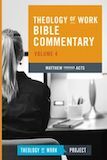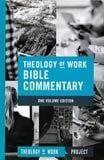Rhythms of Work, Rest, and Worship (Mark 1-4, 6, 13)
Bible Commentary / Produced by TOW Project
The Lord of the Sabbath (Mark 2:23-3:6)
Back to Table of Contents Back to Table of Contents
The Purpose of the Sabbath (Click Here to Read)In this daily reflection from The High Calling Mark Roberts considers how the teaching of Jesus about the purpose of the Sabbath speaks to us today: "In a world so filled with busyness, where electronic communication invades every moment, where people are running ragged and neglecting their most important relationships, we need the gift of rest." |
We have noticed already, in our discussion of Mark 1:21-34, that the Sabbath is integrated into the weekly rhythms of Jesus. The clash that takes place between Jesus and the Pharisees is not over whether to observe the Sabbath but over how to observe it. For the Pharisees, the Sabbath was primarily defined in negative terms. What, they would ask, is prohibited by the commandment to do no work (Exodus 20:8-11; Deuteronomy 5:12-15)?[1] To them, even the casual action of the disciples in picking ears of grain constitutes a kind of work and thus ignores the prohibition. It is interesting that they describe this action as “not lawful” (Mark 2:24), even though such a specific application of the fourth commandment is lacking in the Torah. They regard their own interpretation of the law as authoritative and binding, and do not consider the possibility that they might be wrong. Even more objectionable for them is Jesus’ act of healing (Mark 3:1-6), which is depicted as the key event leading the Pharisees to plot against Jesus.
Making Time Off Predictable and Required (Click Here to Read)Read more here about a new study regarding rhythms of rest and work done at the Boston Consulting Group by two professors from Harvard Business School. It showed that when the assumption that everyone needs to be always available was collectively challenged, not only could individuals take time off, but their work actually benefited. (Harvard Business Review may show an ad and require registration in order to view the article.) Mark Roberts also discusses this topic in his Life for Leaders devotional "Won't Keeping the Sabbath Make Me Less Productive?" |
By contrast with the Pharisees, Jesus regards the Sabbath positively. The day of freedom from work is a gift for humanity’s good. “The Sabbath was made for humankind, not humankind for the Sabbath” (Mark 2:27). Moreover, the Sabbath affords opportunities to exercise compassion and love. Such a view of the Sabbath has good prophetic antecedent. Isaiah 58 links the Sabbath with compassion and social justice in the service of God, culminating with a description of God’s blessing on those who will “call the Sabbath a delight” (Isaiah 58:13-14). The juxtaposition of compassion, justice, and Sabbath suggests that the Sabbath is most fully used as a day of worship by the demonstration of compassion and justice. After all, the Sabbath itself is a remembrance of God’s justice and compassion in delivering Israel from slavery in Egypt (Deuteronomy 5:15).
The first Sabbath account (Mark 2:23-28) is triggered by the disciples’ action of picking ears of grain.[2] While Matthew adds that the disciples were hungry, and Luke describes their action of rubbing the ears of grain between their hands before eating them, Mark simply describes them as picking the grain, which conveys the casual nature of the action. The disciples were probably absently picking at the seeds and nibbling them. The defence that Jesus offers when challenged by the Pharisees seems a little strange at first, because it is a story about the house of God, not the Sabbath.
Have you never read what David did when he and his companions were hungry and in need of food? He entered the house of God, when Abiathar was high priest, and ate the bread of the Presence, which it is not lawful for any but the priests to eat, and he gave some to his companions. (Mark 2:25–26)
Scholars are divided over how — or even whether — Jesus’ argument works according to principles of Jewish exegesis and argumentation.[3] The key is to recognize the concept of “holiness.” Both the Sabbath and the house of God (with its contents) are described as “holy” in Scripture.[4] Sabbath is sacred time, the house of God is sacred space, but lessons that may be derived from the holiness of one may be transferred to the other.
Jesus’ point is that the holiness of the house of God does not preclude its participation in acts of compassion and justice. The sacred spaces of earth are not refuges of holiness against the world, but places of God’s presence for the world, for his sustenance and restoration of the world. A place set apart for God fundamentally is a place of justice and compassion. “The sabbath [and by implication, the house of God] was made for humankind, and not humankind for the sabbath” (Mark 2:27). Matthew’s version of this account includes the detail, “I desire mercy and not sacrifice,” from Hosea 6:6 (Matthew 12:7). This makes explicit the point that we see with more reserve in Mark.
The Purpose of the Sabbath, Part 2 (Click Here to Read)In this daily reflection from The High Calling Mark Roberts considers how the question and the action of Jesus make it clear that the Sabbath is a day for saving life, not just in the particular sense of rescuing someone from a life-threatening situation, but also in the larger sense of bringing people to wholeness. |
The same point emerges in the second Sabbath controversy, when Jesus heals a man in a synagogue on the Sabbath (Mark 3:1-6). The key question that Jesus asks is, “Is it lawful to do good or to do harm on the Sabbath, to save life or to kill?” The silence of the Pharisees in the face of this question serves as a confirmation that the Sabbath is honoured by doing good, by saving life.
How does this apply to our work today? The Sabbath principle is that we must consecrate a portion of our time and keep it free from the demands of work, allowing it to take on a distinctive character of worship. This is not to say that the Sabbath is the only time of worship, nor that work cannot be a form of worship itself. But the Sabbath principle allows us time to focus on God in a different way than the working week allows, and to enjoy his blessing in a distinctive way. Crucially, too, it gives us space to allow our worship of God to manifest itself in social compassion, care, and love. Our worship on the Sabbath flavors our work during the week.
The topic of Sabbath is discussed in depth in the article, Rest and Work at www.theologyofwork.org. Recognizing that there is no single Christian perspective about the Sabbath, the Theology of Work Project explores a somewhat different point of view in the section on "Sabbath and Work" in the article Luke and Work.
Parables at Work (Mark 4:26-29 and 13:32-37)
Back to Table of Contents Back to Table of ContentsMark contains only two parables that are not also found in the other Gospels. Both of them concern work, and both are very short.
The first of these parables, in Mark 4:26-29, compares the kingdom of God to growing grain from seed. It has similarities to the more familiar parable of the mustard seed, which follows immediately afterwards, and to the parable of the sower (Mark 4:1-8). Although the parable is set in the workplace of agriculture, the role of the farmer is deliberately minimized. “He does not know how” the grain grows (Mark 4:27). Instead, the emphasis is on how the kingdom’s growth is brought about by the inexplicable power of God. Nonetheless, the farmer must “rise night and day” to cultivate the crop (Mark 4:26) and go in with his sickle (Mark 4:28) to reap the harvest. God’s miracle is given among those who do their assigned work.
The second uniquely Marcan parable, in Mark 13:32-37, illustrates the need for Jesus’ disciples to watch for the second coming of Jesus. Intriguingly, Jesus says, “It is like a man going on a journey, when he leaves home and puts his slaves in charge, each with his work, and commands the doorkeeper to be on the watch” (Mark 13:34). While he is away, each servant is charged to keep doing his work. The kingdom is not like a master who goes to a far country and promises to eventually call his servants to join him there. No, the master will be coming back, and he gives his servants the work of growing and maintaining his household for his eventual return.
Both parables take it as a given that Jesus’ disciples are diligent workers, whatever their occupation. We will not discuss the other parables here, but refer instead to the extensive explorations in Matthew and Work and Luke and Work at www.theologyofwork.org.
Jesus the Builder (Mark 6:1-6)
Back to Table of Contents Back to Table of ContentsThe Art of Making, the Carpenter (Click to Watch)The Art of Making, The Carpenter from Deep Green Sea on Vimeo. |
An incident in Jesus’ hometown gives a rare insight into his work prior to becoming a traveling preacher. The context is that Jesus’ hometown friends and acquaintances can’t believe that this familiar local boy has become a great teacher and prophet. In the course of their complaints, they say, “What deeds of power are being done by his hands! Is not this the carpenter, the son of Mary and brother of James and Joses and Judas and Simon, and are not his sisters here with us?” (Mark 6:2–3). This is the only passage in the Bible to directly state Jesus’ trade. (In Matthew 13:55, Jesus is called “the carpenter’s son,” and Luke and John do not mention his profession.) The underlying Greek (tekton) refers to a builder or craftsman in any kind of material,[1] which in Palestine would generally be stone or brick. The English rendering “carpenter” may reflect the fact that in London wood was the more common building material at the time the first English translations were made.
In any case, a number of Jesus’ parables take place at construction sites. How much of Jesus’ personal experience might be reflected in these parables? Did he help construct a fence, dig a wine press, or build a tower in a vineyard, and observe the strained relations between the landowner and the tenants (Mark 12:1-12)? Did one of his customers run out of money halfway through building a tower and leave an unpaid debt to Jesus (Luke 14:28-30)? Did he remember Joseph teaching him how to dig a foundation all the way to solid rock, so that the building can withstand wind and flood (Matthew 7:24-27)? Did he ever hire assistants and have to face grumbling about pay (Matthew 20:1-16) and pecking order (Mark 9:33-37)? Was he ever supervised by a manager who asked him to join in a scheme to defraud the owner (Luke 16:1-16)? In short, how much of the wisdom in Jesus’ parables was developed through his experience as a tradesman in the first-century economy? If nothing else, remembering Jesus’ experience as a builder can help us see the parables in a more concrete light.







